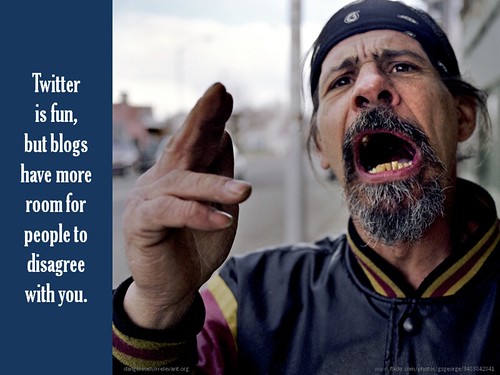Building a Winning Business Reviewed By Bookviews by Alan Caruba
Bookviews by Alan Caruba
Thanks to Alan Caruba for his review of my book Building a Winning Business (found in the Getting Down to Business section found near the bottom of the page).
Bookviews by Alan Caruba
Thanks to Alan Caruba for his review of my book Building a Winning Business (found in the Getting Down to Business section found near the bottom of the page).

Disagreement is good!
Guideline #3 – Invite Disagreement
In the recent HBR article, “How to Cultivate Engaged Employees” author Charalambos Vlachoutsicos encourages inviting disagreement to get employees engaged. He cites an example of the difficulties of managers at a company in Belarus, which has survived three generations under authoritarian communism, to get employees to speak up, disagree and offer opinion – even when they have constructive ideas to contribute. He writes, “Bosses in more open cultures might see this problem as alien,” but I don’t think that’s true. Even in the United States it can be challenging to create a culture where employees feel free to disagree.
At Intertech, we have institutionalized the process of open discussion in a couple of ways. For example, at our annual executive team offsite two-day planning meeting we engage a facilitator (someone not on our staff) to encourage open dialogue. I also remind everyone that either we can be hard on ourselves, or our competition can do so. Disagreement and healthy debate is good! However, no matter how lively the debate may be, we all adhere to one rule: once we make a decision, no one “backtracks or backstabs.” In other words, we move forward in unison.
We also seek the unvarnished feedback of all our employees. I describe in chapter 28 of my book Building A Winning Business the importance of letting everyone weigh in. We do this through an annual half-day all-company “Town Hall” style meeting in which the executive management team is not present. A senior, trusted team member leads the discussion, giving all employees a “safe” way to disagree and bring up ideas without worrying about upsetting senior leaders. Every year this process has led to new good ideas and impacted the direction of our company.

If a tree falls and no one hears it, does it make a sound?
Guideline #2 – Listen Seriously – And Show It
Author Vlachoutsicos believes managers are getting better at listening to employees but “their teams don’t always see it, or even recognize that it matters.” And like the proverbial tree falling in the forest, if it no one hears does it make a sound?
I believe we need to be intentional about letting others know we’re listening and sincerely considering what they have to say. (Chaper 63 of my book Building a Winning Business is called “Leaders Listen.”) One simple way I do this is to make a point of hitting the Do Not Disturb button when I’m in the middle of a conversation with someone in my office. About half the time, the “live” person will tell me to go ahead and take the call. Unless I’m expecting a life or death call, I still send the caller to voice mail. I want the person who took the time to come to my office to talk with me to know he or she has my undivided attention.
It’s also helpful to write down things people tell you as they are speaking. This communicates to them that you are, indeed, listening and that you consider what they’re saying to be important enough to write down and remember!
I’ve also learned a little tip from talking with a counselor when communicating with my wife: paraphrase what you think you’re hearing the other person say. You might discover something amazing, such as you didn’t really understand what the other person was trying to communicate at all! This simple little technique can save everyone a lot of confusion, hurt feelings or anger. . . plus it greatly improves your odds of actually understanding what another is saying.
One of my mentors, Performark founder and retired chief executive officer Joe Lethert shared the best advice he ever received with me. It was, “Seek first to understand and then to be understood.” That advice has served me well over the years, keeping me from jumping to hasty conclusions or rushing to solve a problem for which someone else already has found a creative solution.

My thanks to Michelle Kaye Malsbury of Bookpleasures.com for her review of my book Building a Winning Business.

Churchill was wise!
Harvard Business Review’s September issue is chock full of great articles, but one in particular caught my eye: “How to Cultivate Engaged Employees” by Charalambos Vlachoutsicos. The author, a former international business person and current adjunct professor in the international MBA program at Athens University of Economics and Business, lays out six basic guidelines for encouraging employees to be engaged and excited about your mission. He believes, and I agree, that the behavior of managers can reinforce or destroy a sense of mutuality between employees and the organization. I’m going to explore each of the six guidelines in this post and the five that will follow.
Guideline #1: Be modest
This might seem counter-intuitive to anyone who has worked hard to climb a business ladder. After all, hiding your light under the proverbial bush is not the traditional way to shine at work! But as managers we have to find a way to cultivate the light in others, which means standing back a bit so we don’t cast a shadow on employees (if you’ll forgive the tortured metaphor!). As I describe in chapter 57 of my book Building a Winning Business, leaders let the light shine on others!
This isn’t as difficult as you might think. Just make a concentrated effort to give away credit when it is deserved. And always err on the side of giving too much praise versus not enough. I believe it is important to give specific, sincere praise and to put it in writing when possible. Sharing credit will pay you back in spades as people become more energized and excited about their work, realizing that their effort is important and recognized.
Besides giving away credit, modest leaders take the blame and then quickly move on to coming up with solutions. I’m very intentional about pointing out my own past business mistakes, which I believe has helped to create a culture at Intertech in which people are not afraid to fail. Everyone has heard me talk my own mistakes and problems, so they know it’s ok to try something and fail themselves. As my father used to tell me, “If you do nothing, you won’t make any mistakes.